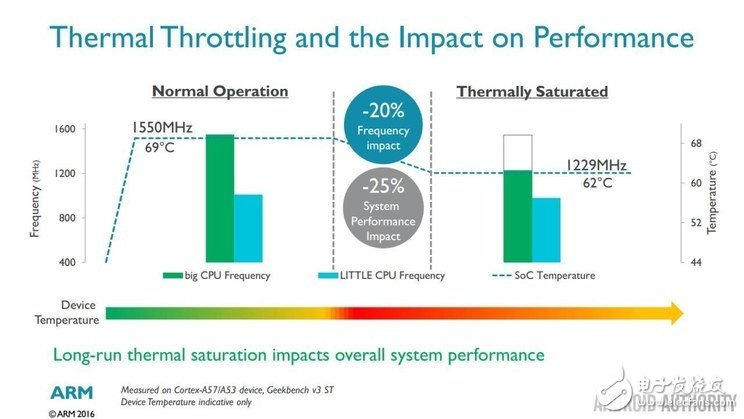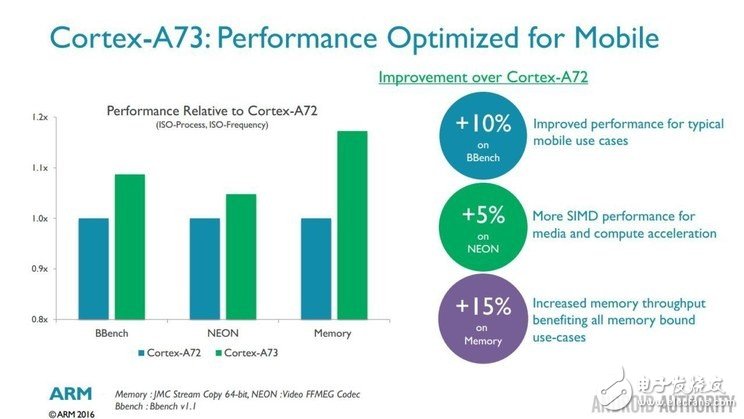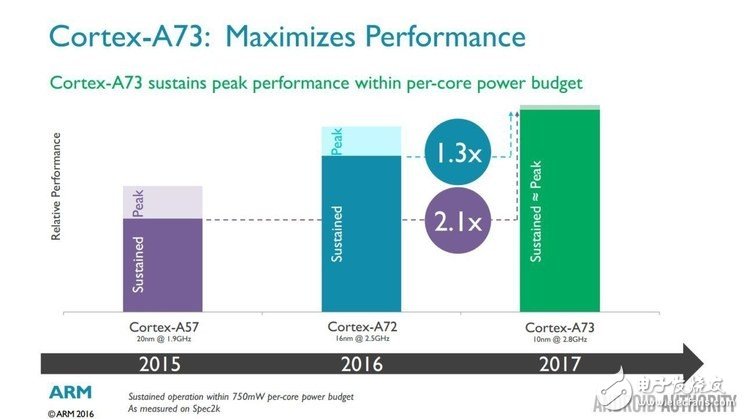If you pay attention to the mobile SoC (System on Chip system-on-chip, the so-called "processor" is part of the SoC), you should not be familiar with the two names ARM and Cortex. In the smartphone market, except for a handful of products from Intel, whether your mobile phone SoC comes from Qualcomm, MediaTek, Samsung or Apple, the CPU part is almost all bought from the ARM company in the UK.
In the past few years, although more and more manufacturers such as Qualcomm, Apple, Samsung, etc. have begun to use the ARMv8 instruction set to build their own high-end CPU architecture, ARM's public version of the CPU architecture still occupies a huge mobile processor. The share, especially in the middle and low-end markets, is much more straightforward than the "toss" autonomous architecture.
The widely used ARM public version CPU architectures are mainly A53, A57, and A72. Among them, A53 is biased towards low power consumption and performance is relatively poor. A57 and A72 are biased in performance, and A72 is a small modified version of A57.
In the CPU that locates the high-end SoC, in order to balance performance and power consumption, the A57/A72 (large core) and A53 (small core) are often used together—the so-called big.LITTLE architecture. For example, Qualcomm's Snapdragon 810 uses four A53s and four A57 cores, and later introduced the Kirin 950/955 with four A53s and four A72 cores. In the mid- to low-end market with higher sales volume, it is basically the low-cost A53 world. The CPU parts of SoCs such as Qualcomm Xiaolong 617/625 and MediaTek Helio P10 adopt the A53 architecture.
Fever makes the mobile phone CPU unable to "fire fully open"
From the current performance, the low-performance, low-heat A53 architecture is enough to make the simple daily operation "no card", but if you want to ensure smooth rendering of complex web pages, playing large games, rendering video, or To make the app faster, you have to count on the high-performance A57 or A72 architecture.
However, whether it is the A57 or the improved version of the A72, when the CPU is "full-fire" and runs at the highest performance, the heat is very large, exceeding the maximum limit that the phone itself can withstand. For this reason, CPUs with the A57/A72 architecture cannot run in the highest performance mode for long periods of time.
When you open the app and render the web page, you only need to run the CPU at full speed in a short period of time. After completing the task, the CPU will quickly recover from the high-heat "full blood" state to low heat and can continue to run. The "normal" state, so the high heat generated by the CPU part of the A57/A72 is often not a problem. In fact, it is precisely because the A57/A72 CPU can be used in a short period of time to make the high-profile flagship machine use faster than the low-end and mid-range phones.

However, when performing tasks that require the CPU to be in a high-performance state for a long time, such as playing 3D games or rendering video for a long time, the CPU (and GPU) generates too much heat, so the system will force the phone to be "burned out". The CPU (and GPU) is down or even partially turned off, causing a significant drop in performance and the phone becomes a card. For example, when playing a large game such as NBA 2K, even if it is using a flagship mobile phone (especially Android flagship), the mobile phone often "plays hotter and hotter and gets hotter", which is why.
So is there a CPU architecture that, when running in the highest performance mode, is the heat still in the range of the phone's thermal dissipation while still having the high performance of the A57/A72? This is the design goal of ARM's next-generation Cortex-A73 CPU architecture.
A73 architecture: the highest performance is not hot
The Cortex A73 was just released at the Computex 2016 Taipei International Computer Show. Let's take a look at some of its parameters.
Like the A53/A57/A72, the A73 still features a 64-bit ARMv8 architecture with a maximum clock speed of 2.8GHz and supports the big.LITTLE size core design, which can be used in 10nm, 14/16nm or even "old" 28nm processes.

In the 10 nm process, the A73 achieves a 30% improvement in performance while reducing power consumption by 30% compared to the A72 in the 16 nm process. With the same 16nm process, the A73's overall performance is 10% higher than the A72, SIMD multimedia processing performance is increased by 10%, and memory performance is increased by 15%.
However, the biggest surprise of the A73 is not the absolute performance improvement, but the heat performance in the highest performance state.

As we mentioned above, whether it is the A57 or A72 architecture, the processor is very hot in the highest performance mode and cannot run stably for a long time. According to the information provided by ARM, when the A73 is running in the highest performance mode, its heat is almost exactly the same under the sustained performance mode that can run stably for a long time. In other words, CPUs with the A73 architecture can continue to operate in the highest performance mode without being forced down by the processor overheating – something that was not found in any previous generation of ARM processors.
However, what needs to be explained here is that a complete mobile phone SoC includes a CPU (processor), a GPU (graphics card), an ISP (image signal processor), a DSP (digital signal processor), a memory controller, a communication baseband, and the like. Component. In addition to the CPU we talked about above, the GPU is another big fan. Therefore, even if the chip manufacturer puts its own processor into the A73 architecture (or modified A73), it cannot guarantee that the mobile phone will not overheat and down during use.
the power Connectors we provide overmolding solutions and modular tooling.
We also offer to the OEM and distributor users a diversified line of strain / flex reliefs and grommets, such as Solid, Solid-Rib, Uniflex, Multiflex, in standard off the shelf or custom designs.
Overmolding the power connectors offers significant opportunities for cable improvements with higher pull strength not available with conventional backshells. Our technical staff is ready to help you from design and prototyping to small production run, assistance, and training.
Our team is ready to help with any of the following power connectors projects: overmolding mini fit jr. and mini-fit sr. connectors, , overmolded cables with micro fit terminations, sabre molded cable asemblies, amp duac overmolded power connectors, mate-n-lock power cables, power connector overmolding services, power connector molding, design and prototype of power cables across the board, small run molded power connecotrs , molded cable manufacturing, overmolding connectors for any power applications
Strain/flex Reliefs And Grommets
Strain Reliefs And Grommets,Flex Reliefs And Grommets,Cable Strain Reliefs,Cable Flex Reliefs,Cable Grommets,Molded Strain Relief
ETOP WIREHARNESS LIMITED , http://www.oemmoldedcables.com